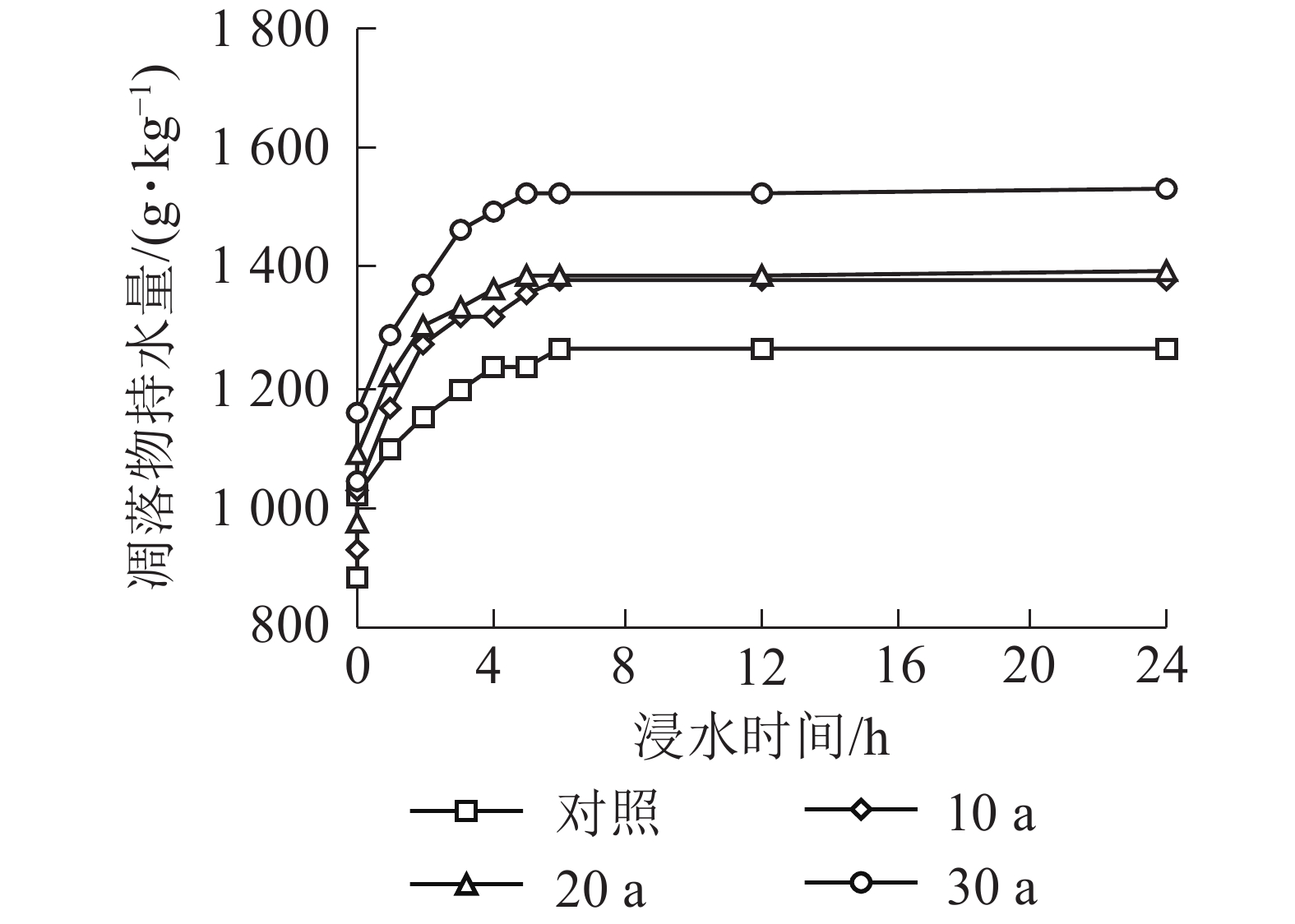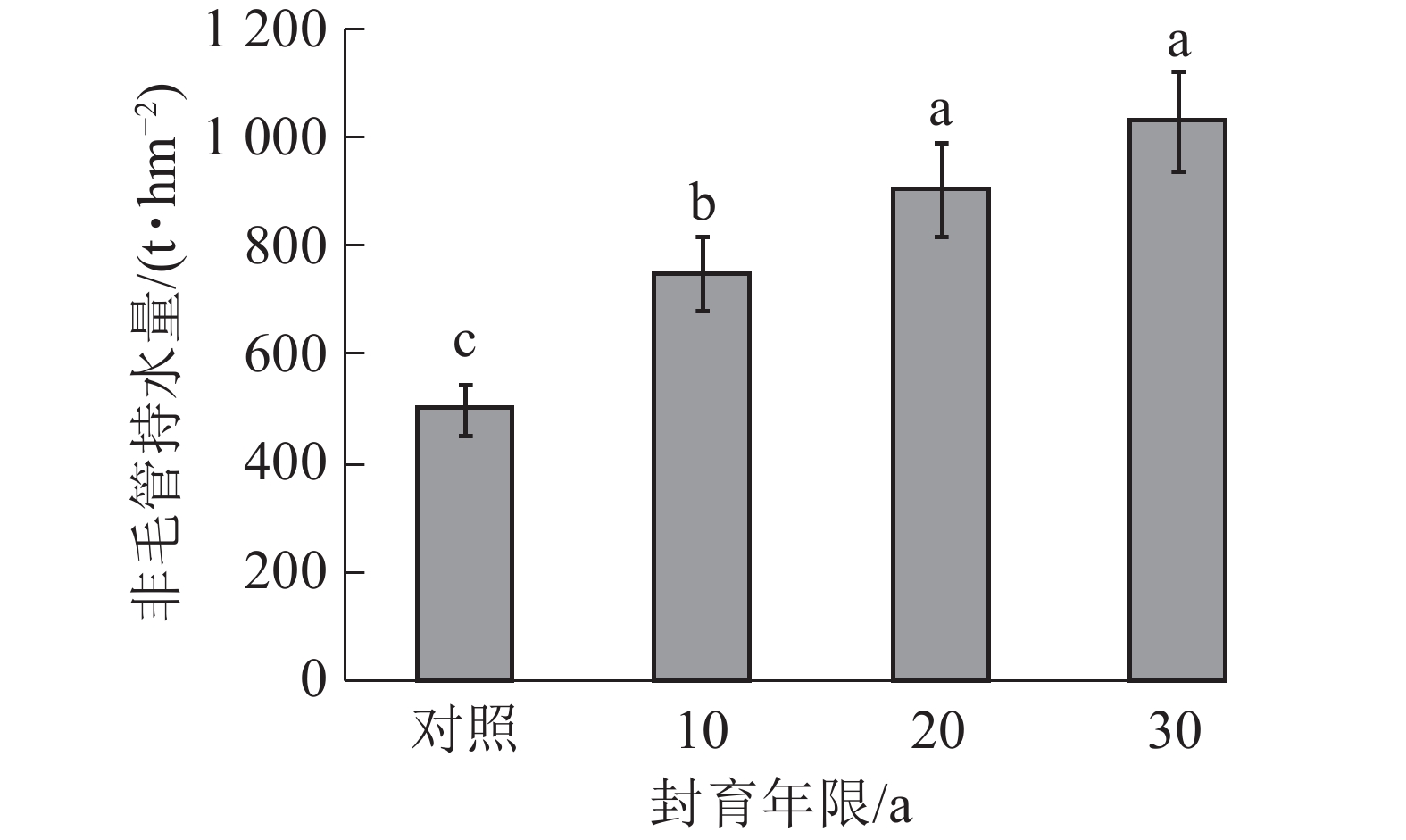-
毛竹Phyllostachys edulis是中国重要的森林资源,仅浙江省分布面积就达81.67×104 hm2,占全省森林面积的13.43%[1],具有生长快、用途广、可持续性强等特点。以往的研究主要集中于毛竹高效栽培后林下生物及土壤的变化等方面。研究表明:毛竹强度经营显著降低了林下植物多样性、丰富度指数[2]、灌草生物量、凋落物储量[3]和土壤总孔隙度[4],土壤有机质、碱解氮、有效磷、速效钾及铵态氮含量也随着毛竹栽培年限的增加而下降[5]。集约经营20 a后,土壤总有机碳、微生物量碳分别下降了34.70%、49.35%[6],长期经营将导致毛竹林地力衰退[7]。但随着社会、经济的快速发展,竹材价格逐年下降[8],劳动力成本持续上升[9],导致毛竹砍伐人工成本大于竹材销售收入,造成了浙江省较大面积的集约经营毛竹林疏于管理,处于自然封育状态。自然封育后,林下植被多样性、灌草生物量、凋落物储量等是否会增加?土壤有机碳、容重、孔隙度等土壤质量指标是否也可能进一步提升?水源涵养是森林生态系统的重要生态功能,其中凋落物层与土壤层占森林涵养水源能力的90%以上[10],已成为森林水文学研究的热点。研究表明:不同密度毛竹林凋落物持水性能存在较大差异,3 000株·hm−2的林分凋落物储量和最大持水量均为最高[11];毛竹林土壤总孔隙度、非毛管孔隙度、最大持水量和水源涵养能力显著大于杉木Cunninghamia lanceolata林和马尾松Pinus massoniana林[12];江西大岗山常绿阔叶林转变成毛竹林后,凋落物的水文生态功能增强[13];闽北不同林分水源涵养综合能力从大至小依次表现为常绿阔叶林、毛竹混交林、杉木纯林、毛竹纯林[14]。自然封育后毛竹林凋落物和土壤持水功能是如何变化,至今还未见报道。鉴于此,本研究采用时间代替空间的方法,全面调查和研究自然封育10、20、30 a和常规经营的毛竹林凋落物和土壤持水效能,旨在揭示毛竹林生态系统在自然封育过程中凋落物储量、持水性能和土壤水文性质的变化规律,以期为评价不同类型毛竹林水源涵养功能提供科学依据。
HTML
-
研究区位于有“中国竹子之乡”的浙江省杭州市余杭区境内,地理坐标为30°25′28.10″~30°33′34.00″N,119°42′02.71″~119°50′35.22″E,属于北亚热带南缘季风气候区,年平均气温16.2 ℃,多年平均降水量1 391.8 mm,年平均相对湿度76%,无霜期199~328 d。
-
2017年7月,在查阅杭州市余杭区森林资源经营档案和全面踏查的基础上,选择余杭百丈镇和鸬鸟镇封育年限分别为10、20和30 a的毛竹纯林为研究对象,以常规经营毛竹林为对照,设置不同封育年限样地各9个,共计36个样地,样地面积为30 m×30 m[15]。封育毛竹林常年没有人为活动干扰,对照毛竹林每年5月上旬、中旬施肥1次,施用600 kg·hm−2的复合肥[m(N)∶m(P2O5)∶m(K2O)为15∶15∶15],肥料地表撒施,结合松土垦复15 cm左右。毛竹砍伐集中在小年。样地基本情况如表1所示。
封育年限/a 土壤类型 海拔高度/m 坡度/(°) 密度/(株·hm−2) 平均胸径/cm 平均高/m 对照 红壤 275±71 15.3±7.5 2 345±257 10.2±0.66 13.2±1.0 10 红壤 397±75 20.2±8.7 3 773±554 10.1±0.79 13.5±1.2 20 红壤 497±80 22.7±7.7 5 173±459 9.6±0.61 13.5±1.4 30 红壤 509±87 19.9±9.8 5 210±574 7.8±0.71 13.5±1.5 Table 1. Basic situation of Ph. edulis forest in different natural exclosure years
-
在样地内的中心位置,挖取1个土壤剖面,按照0~10、10~30、30~60 cm土壤深度用200 cm3环刀取样,在实验室测定土壤容重、总孔隙度、毛管孔隙度、非毛管孔隙度、最大持水量、毛管持水量和非毛管持水量[16]。在样地的4个角和中心位置共布设5块1 m×1 m小样方,收集样方内全部凋落物,准确称量后,分取部分样品,带回实验室在85 ℃烘箱中烘干至恒量,计算自然含水率、凋落物储量。采用室内浸泡法测定凋落物持水特性[17]。
-
用Excel 2013、SPSS 19.0对数据进行处理,采用单因素方差分析,利用Duncan法进行多重比较和差异显著性分析(P<0.05)。
1.1. 研究区概况
1.2. 试验设计
1.3. 样品采集与分析
1.4. 数据处理
-
自然封育10、20、30 a的毛竹林凋落物储量为5.2、9.6、11.2 t·hm−2,分别比对照(2.8 t·hm−2)增加85.7%、243.9%和300.7%。随着封育年限的延长,毛竹林凋落物累积越多,封育20、30 a毛竹林凋落物储量显著高于10 a毛竹林,也显著高于对照(P<0.05,图1)。
-
从图2可知:随着浸水时间的延长,毛竹林凋落物持水量增加表现为“快—缓慢—稳定”的规律,不同封育年限毛竹林凋落物浸水1.00 h的总持水量占24.00 h的84.1%~87.5%。经过相同时间浸泡的毛竹林凋落物持水量从大到小依次呈现为自然封育30、20、10 a、对照,自然封育毛竹林凋落物的持水量显著高于对照(P<0.05),但不同封育年限间没有显著差异。由图3可知:不同封育年限毛竹林凋落物持水速率与浸水时间变化规律相似,即0.25 h内持水速率最大,0.25~2.00 h的持水速率急剧下降,2.00 h后持水速率基本稳定,在浸水4.00 h后不同封育年限凋落物持水速率曲线基本重叠,达饱和状态。从表2可知:毛竹林凋落物持水量(y)与浸水时间(t)之间为对数函数关系,可用y=alnt+b表示,它们之间的相关性达显著水平(P<0.05);毛竹林凋落物持水速率(y)与浸水时间(t)之间为指数函数关系,关系式为y=ae−bt,它们之间的相关性也达显著水平(P<0.05)。
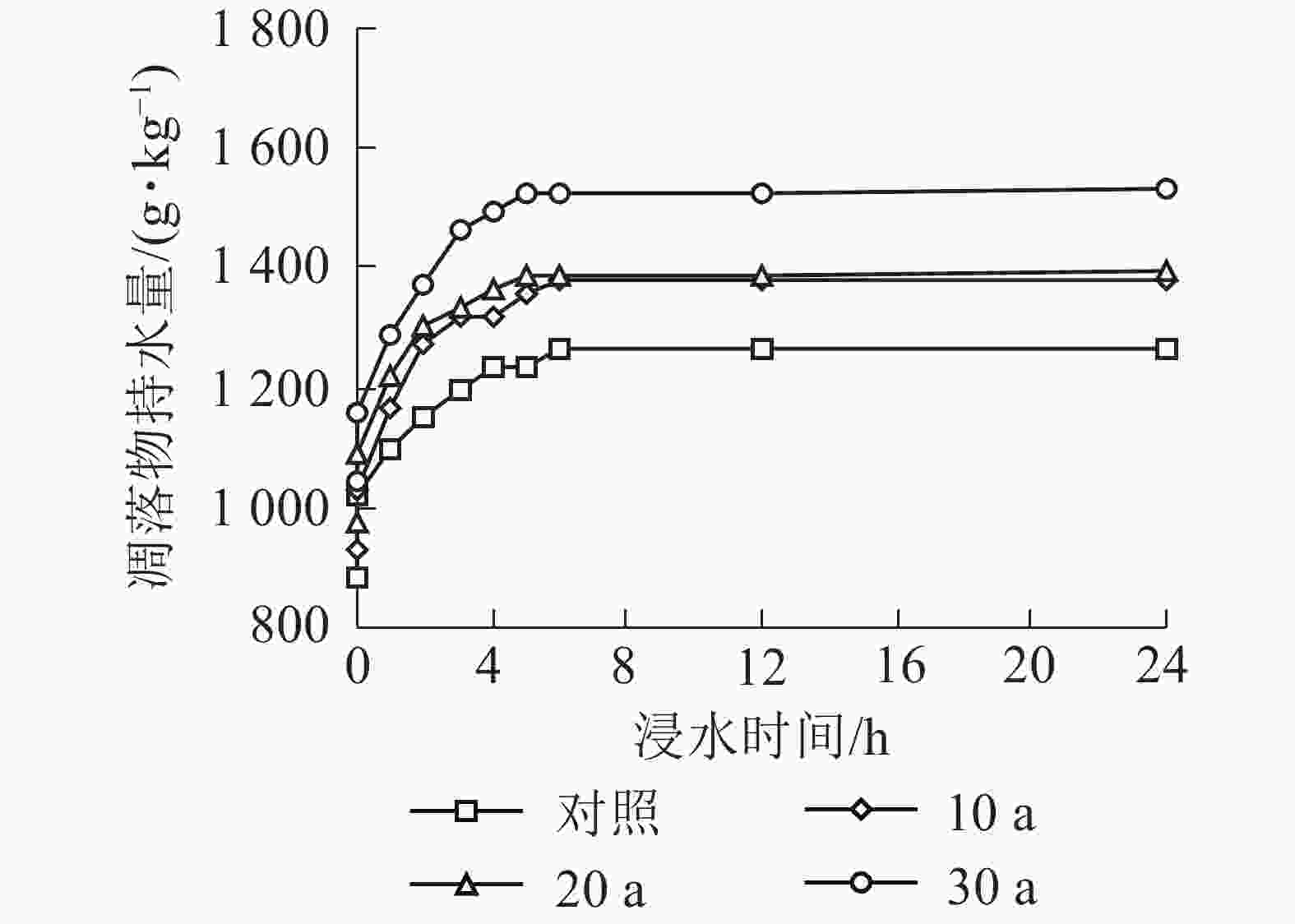
Figure 2. Change of water holding quantity of litter of Ph. edulis forest in different natural exclosure years
封育年限/a 凋落物持水量(y)与浸泡时间(t)的关系 凋落物持水速率(y)与浸泡时间(t)的关系 方程式 R2 方程式 R2 对照 y=172.4lnt+901.1 0.984 1* y=3 739e-0.39t 0.964 9* 10 y=215.3lnt+929.1 0.962 2* y=3 858e-0.37t 0.966 2* 20 y=194.1lnt+991.5 0.955 7* y=4 068e-0.38t 0.965 3* 30 y=216.8lnt+1 075.0 0.965 4* y=4 395e-0.37t 0.960 1* 说明:*表示相关性达显著水平(P<0.05) Table 2. Correlativity between water holding quantity, water absorption rate and immersion time of Ph. edulis forest in different natural exclosure years
-
随着封育年限的延长,毛竹林凋落物层最大持水量显著增强(P<0.05),自然封育10、20、30 a的毛竹林凋落物最大持水量分别比对照毛竹林(8.17 t·hm−2)增加了92.0%、307.4%和402.8%(表3)。毛竹林凋落物层有效拦蓄量、有效拦蓄率随自然封育年限的变化规律与最大持水量的变化趋势基本一致(表3)。与对照相比,自然封育10、20、30 a后毛竹林地凋落物有效拦蓄量分别增加了87.7%、294.9%、377.6%,自然封育毛竹林凋落物层有效拦蓄量显著高于对照(P<0.05),且不同封育年限间有显著差异(P<0.05)。
封育年限/a 自然含水率/% 最大持水率/% 最大持水量/(t·hm−2) 最大拦蓄率/% 有效拦蓄量/(t·hm−2) 有效拦蓄率/% 对照 11.6±1.2 d 290.9±32.3 b 8.17±0.82 d 279.3±25.3 b 6.62±0.71 d 235.7±20.1 b 10 17.5±1.9 c 301.7±21.1 ab 15.69±1.63 c 284.2±29.2 ab 12.43±1.35 c 238.9±22.9 ab 20 22.3±2.4 b 345.6±35.2 a 33.28±3.49 b 323.3±33.7 a 26.14±2.33 b 271.5±24.3 a 30 29.4±3.1 a 366.1±35.9 a 41.08±4.05 a 336.7±34.1 a 31.62±3.02 a 281.8±23.4 a 说明:不同字母表示不同自然封育年限间存在显著差异(P<0.05) Table 3. Waterholding capacity of litter of Ph. edulis forest in different natural exclosure years
-
从表4可知:随着土层深度的增加,毛竹林土壤容重呈现增大趋势,而土壤总孔隙度和非毛管孔隙度则表现为降低的趋势。毛竹林0~10、10~30 cm土层土壤容重随着自然封育年限的延长而下降,与对照相比,自然封育10 a后,土壤容重分别下降了17.8%~26.5%、16.5%~24.0%(P<0.05),而30~60 cm土层土壤容重在不同封育年限之间没有显著差异。毛竹林土壤总孔隙度和非毛管孔隙度从大到小总体表现为自然封育30 、20 、10 a、对照,其中自然封育20、30 a土壤0~10、10~30 cm土层总孔隙度显著高于对照(P<0.05),30~60 cm土层总孔隙度在不同封育年限间的差异并不显著;自然封育10、20、30 a毛竹林不同土层土壤非毛管孔隙度均显著高于对照(P<0.05);而毛竹林相同深度土层的土壤毛管孔隙度在不同处理间没有显著差异(P>0.05)。
土层/
cm封育
年限/a土壤容重/
(g·cm−3)总孔隙度/% 毛管孔隙度/
%非毛管
孔隙度/%量大持水量/
(t·hm−2)毛管持水量/
(t·hm−2)非毛管持水量/
(t·hm−2)0~10 对照 1.12±0.10 a 57.58±5.65 b 47.52±4.61 a 10.06±1.11 b 575.81±52.31 b 475.20±48.12 a 100.61±10.23 b 10 0.92±0.08 b 65.25±6.32 ab 47.08±4.83 a 18.17±1.82 a 652.48±61.64 ab 470.77±47.36 a 181.71±15.98 a 20 0.84±0.09 b 72.39±7.46 a 51.82±5.02 a 20.57±2.06 a 723.90±70.92 a 518.18±51.24 a 205.72±19.37 a 30 0.82±0.08 b 76.71±7.81 a 54.89±5.55 a 21.82±2.13 a 767.09±72.57 a 548.87±53.65 a 218.22±20.84 a 10~30 对照 1.21±0.10 a 54.34±4.24 b 46.10±4.77 a 8.24±0.81 c 1 086.79±101.21 b 921.99±92.34 a 164.80±15.49 c 10 1.01±0.09 b 61.89±5.12 ab 48.37±4.68 a 13.52±1.32 b 1 237.74±121.08 ab 967.34±96.72 a 270.40±26.32 b 20 0.95±0.09 b 64.15±5.36 a 47.63±4.91 a 16.52±1.74 ab 1 283.02±125.93 a 952.62±94.19 a 330.40±31.95 ab 30 0.92±0.09 b 65.28±5.61 a 45.69±4.59 a 19.59±2.01 a 1 305.66±128.16 a 913.86±90.84 a 391.80±40.57 a 30~60 对照 1.27±0.12 a 50.57±5.15 a 42.72±4.22 a 7.85±0.79 c 1 516.98±148.29 a 1 281.48±122.22 a 235.50±24.15 c 10 1.25±0.11 a 52.83±5.23 a 42.82±4.28 a 10.01±1.02 b 1 584.91±149.67 a 1 284.61±127.69 a 300.30±29.36 b 20 1.23±0.13 a 53.58±5.42 a 41.23±4.19 a 12.35±1.13 a 1 607.55±155.21 a 1 237.05±121.38 a 370.50±35.29 ab 30 1.23±0.12 a 53.58±5.31 a 39.46±4.03 a 14.12±1.46 a 1 607.55±160.36 a 1 183.95±109.67 a 423.60±40.73 a 说明:同一土层同一列中不同字母表示不同自然封育年限间存在显著差异(P<0.05) Table 4. Soil property and waterholding quantity of Ph. edulis forest in different natural exclosure years
-
从表4可知:同一土层毛竹林土壤最大持水量和非毛管持水量从大到小排序为自然封育30 a、20 a、10 a、对照。自然封育20和30 a后,0~10 、10~30 cm土层的土壤最大持水量比对照显著提高了18.1%~33.2%(P<0.05),30~60 cm土层最大持水量在不同处理间没有显著差异;自然封育毛竹林0~10、10~30、30~60 cm土壤非毛管持水量均显著高于对照(P<0.05),与对照相比,增加了27.5%~137.7%;同一土层毛竹林土壤毛管持水量在不同封育年限间没有显著差异(P>0.05)。
将不同土层持水量相加,得到0~60 cm土壤持水量,毛管持水量(2 646.68~2 722.71 t·hm−2)和最大持水量(3 179.58~3 680.29 t·hm−2)在不同自然封育毛竹林间并没有显著差异。从图4可知:自然封育显著增加了毛竹林非毛管持水量,与对照(500.91 t·hm−2)相比,非毛管持水量显著增加了50.2%~106.3%(P<0.05),其中自然封育20、30 a又显著高于自然封育10 a(P<0.05,图4)的非毛管持水量。
2.1. 不同封育年限毛竹林凋落物储量及持水性能
2.1.1. 不同封育年限毛竹林凋落物储量
2.1.2. 不同封育年限毛竹林凋落物持水过程
2.1.3. 不同封育年限毛竹林凋落物持水能力
2.2. 不同封育年限毛竹林土壤物理性质及土壤持水性能
2.2.1. 不同封育年限毛竹林土壤物理性质
2.2.2. 不同封育年限毛竹林土壤持水性能
-
森林凋落物在水土保持和水源涵养方面起着积极作用[18],同时参与养分循环、碳固持[19],其储量的大小受到森林类型、树种组成以及林分密度、生态恢复措施等因素的影响[11,14]。油松Pinus tabulaeformis人工林凋落物的储量随着封育时间的延长而增加[20],竹阔混交林凋落物储量大于毛竹纯林[14]。随着密度增大,毛竹林凋落物储量也随之增加[11]。毛竹林活立木和枯死竹的密度随着封育年限的延长而显著增加[15]。本研究中,毛竹林凋落物储量随着自然封育年限的延长而显著增多。这主要是随着密度的增大,每年大量竹叶的凋落及部分枯死竹成为枯倒竹,从而增加了凋落物的归还量。另外,常规经营毛竹林每年进行林地清理、扰动,减少了凋落物的归还,同时加速了凋落物的分解,造成常规经营毛竹林凋落物储量比自然封育毛竹林低,这与干扰樟子松Pinus sylvestris var. mongolica林凋落物储量低于封育林的结果相似[21]。
不同处理毛竹林凋落物的持水过程和持水速率的变化具有相似的规律,这与浙江省主要森林类型的研究结果一致[22]。凋落物持水量与浸泡时间存在显著的对数函数关系,而凋落物持水速率与浸水时间的关系为指数函数。凋落物持水能力受森林类型、凋落物储量及组成等因素的影响[23]。毛竹林凋落物最大持水量、有效拦蓄量、最大持水率、有效拦蓄率均随着自然封育年限的延长而增加。与常规经营比,自然封育10~30 a毛竹林地凋落物最大持水量、有效拦蓄量显著增加,且不同年限间的差异均达显著水平;而毛竹林凋落物最大持水率、有效拦蓄率在自然封育20 a后才显著高于常规经营。这主要是因为凋落物最大持水量、有效拦蓄量与凋落物储量有密切关系。本研究中,自然封育10 a后,毛竹林凋落物储量已显著高于常规经营。自然封育显著增强了毛竹林的持水能力,与天然封育显著增加了桃林口水库凋落物拦蓄量的研究结果相似[24]。
土壤孔隙度越大,容重越小,表明土壤结构越疏松,越有利于雨水下渗,减少地表径流[25]。自然封育提高了毛竹林土壤非毛管孔隙度和表层(0~30 cm)土壤总孔隙度,降低了表层土壤的容重,改善了土壤水文物理性质,增强了表层土壤保水能力。随着封育年限的延长,土壤的水文物理性质改善明显,这与其他退化群落封育后的研究结果相似[16]。土壤的渗透性能取决于非毛管孔隙,非毛管孔隙中滞留的重力水在调蓄水方面的作用更为重要,更加有利于涵养水源。自然封育后,毛竹林不同深度土壤非毛管持水量增加,封育20 a后,表层(0~30 cm)土壤最大持水量也显著提高。土壤非毛管持水量和表层土壤最大持水量随着封育年限的延长而增大。随着封育年限的增加,地表积累的凋落物越来越多,表层土壤水文物理性质不断改善,土壤蓄水能力随之增强,毛竹林凋落物和土壤持水效能持续增大。




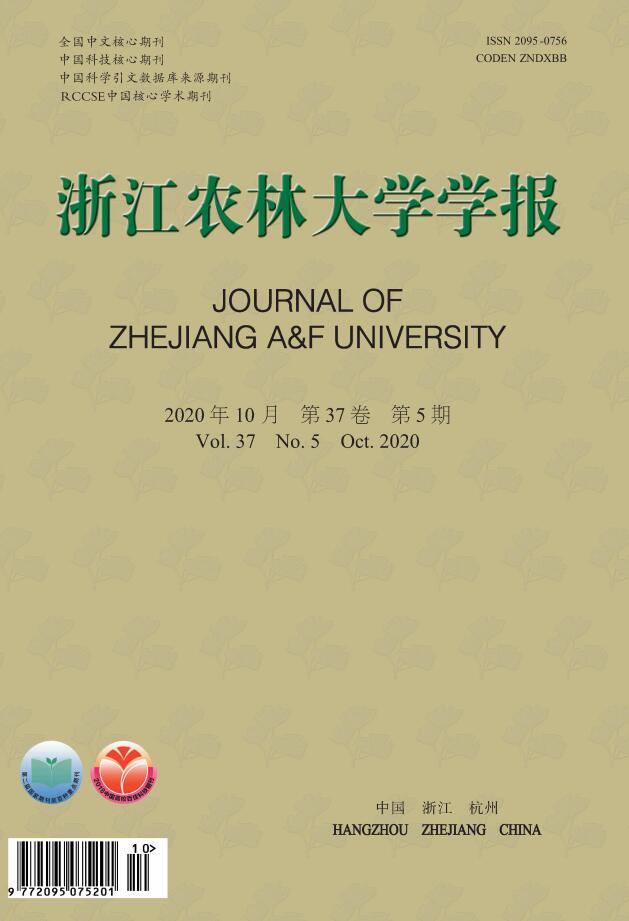


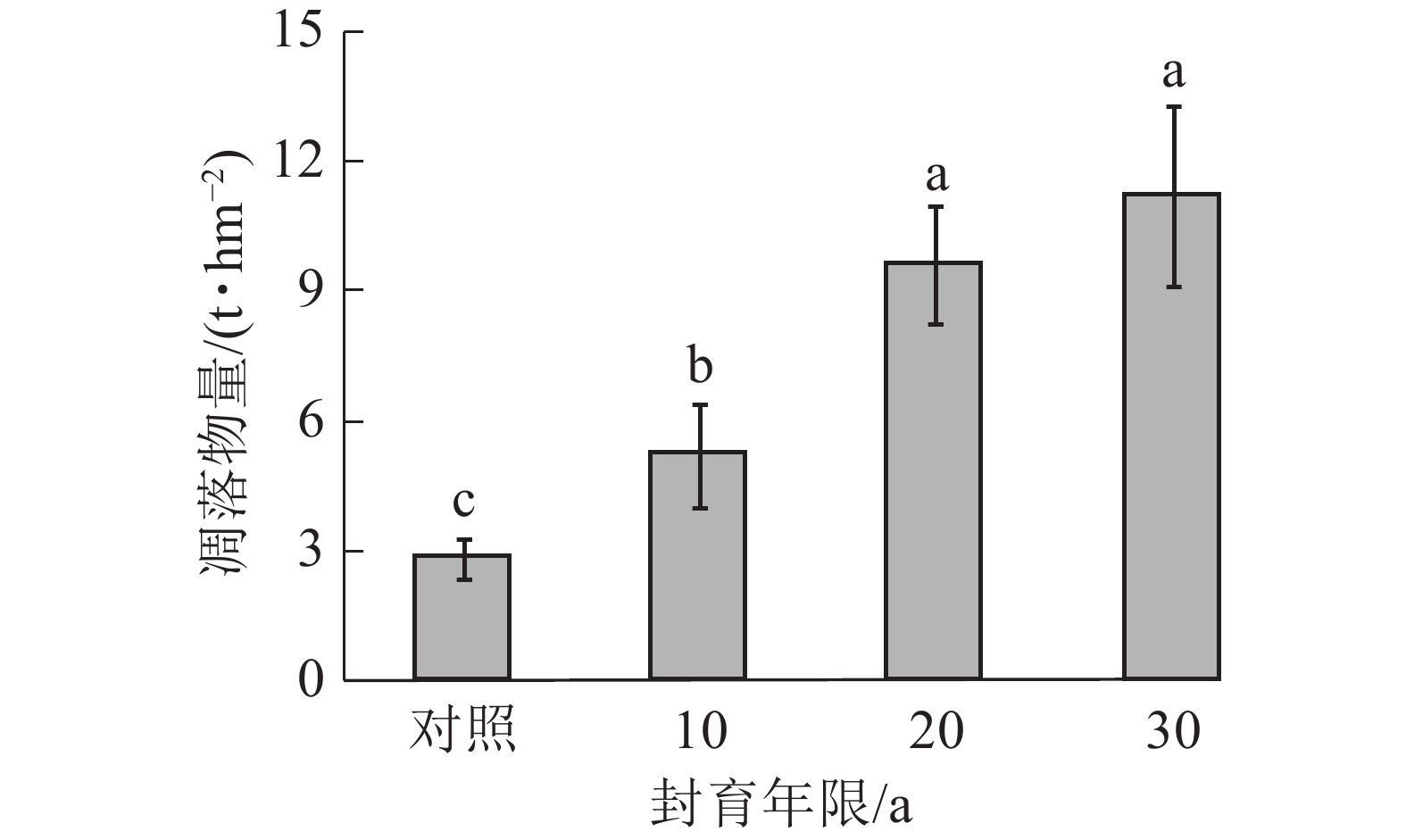


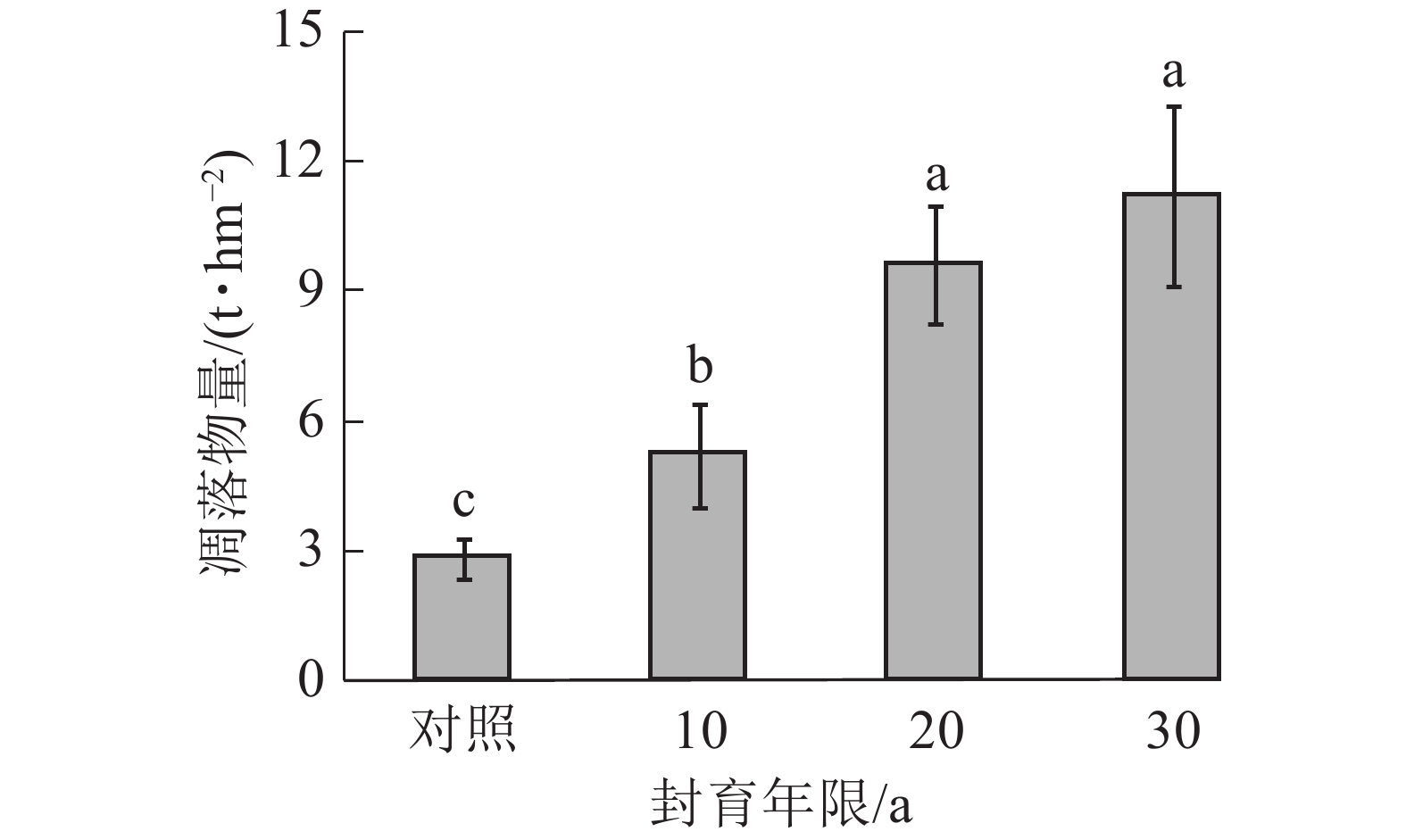
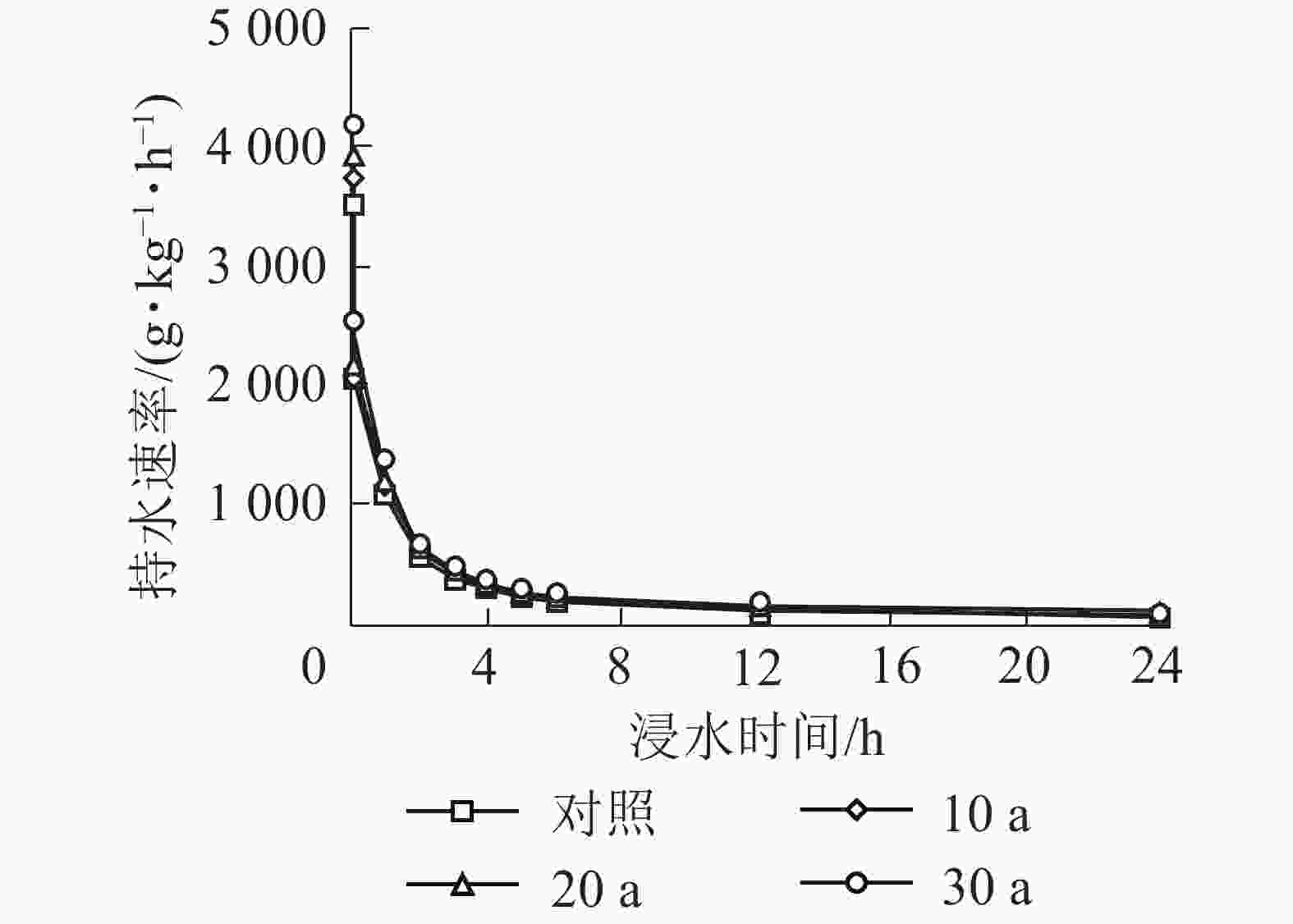
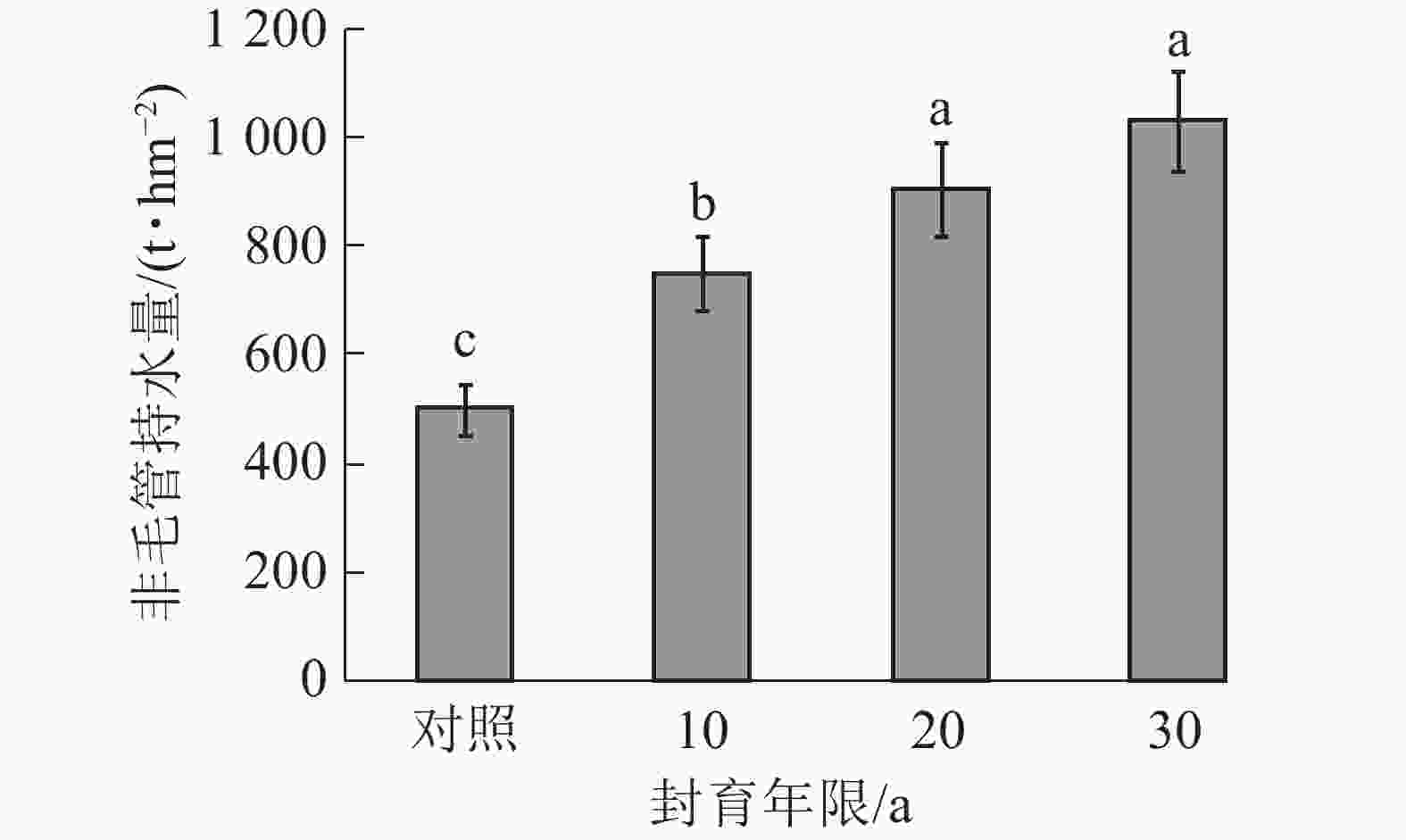
 DownLoad:
DownLoad:
